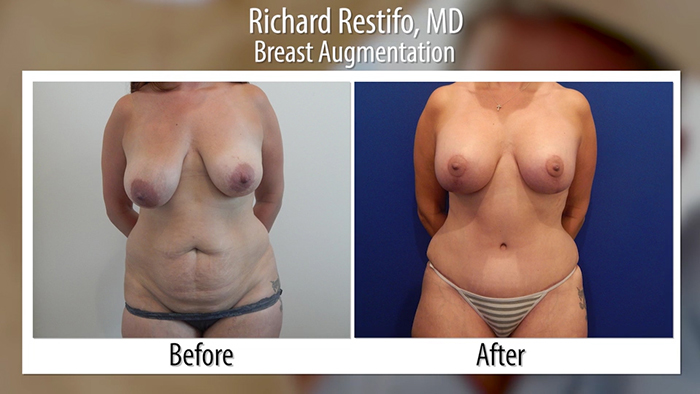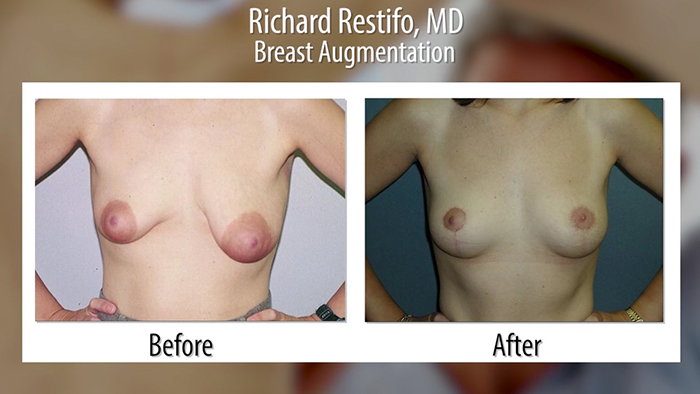Breast asymmetry is a fact of life. Most of us have uneven breasts, defined as a difference in form, position or volume of the breast. And though we live in a culture that is always striving for perfection, it is really these subtle differences that make us human. For some women, however, these differences are extreme.
In fact, even a moderate degree of asymmetry can make a woman feel self-conscious in certain situations and clothing, such as a bathing suit. Thankfully, there are quite a few surgical breast procedures for fixing breast asymmetry. Dr. Richard J. Restifo of Orange, CT discusses your options.
Breast Asymmetry Is Normal
It is perfectly normal to have uneven breasts. In a recent study of a 100 women who wanted a breast augmentation, it was discovered that 88% had some degree of breast asymmetry. Even so, “there is a tendency to equate even with normal. It’s nice to have a matching pair,” explains Dr. Restifo.
Restifo is finding that more and more patients are coming in wanting to discuss their asymmetric breasts. What he’s discovered is that even a slight amount of unevenness can make a patient feel self-conscious – particularly in certain pieces of clothing like a bikini, halter top or a tight-fitting tank.
There are also many different kinds of asymmetry. Breasts can be unmatched in respect to:
- size
- shape
- position of the nipple
Or a patient may be uneven in all three categories. If a woman feels that her breasts are so out of whack that it is adversely affecting her life, then the first thing that needs to be done is to schedule a consultation with a board certified plastic surgeon with a lot of breast surgery experience. An in-person exam is crucial for determining the severity of asymmetry as well as whether or not something can be done to improve the situation surgically.

Fixing Breast Asymmetry
Breast asymmetry can be fixed surgically with either a breast lift, a breast augmentation, a breast reduction or a combination of the three. Many women will come in to a consultation liking one breast size and shape more than the other, and they only one to operate on the “bad” side. In the best case scenario, experienced surgeons are able to use the “good side” as a model, and then match the opposite breast by either lifting it, enlarging it or reducing it.
Unfortunately, operating on only one breast will not always delver a patient’s desired outcome. Sometimes Restifo needs to explain to the patient that she will not get symmetry without doing something to both sides.
For example, in a teenage patient where one breast did not develop as much as the other, there might be a normal breast on one side, and a much smaller breast on the other. That patient will often come in asking for just an implant on the smaller side. “But you won’t have the same shape because your right breast has much more skin and the nipple is much lower. So, you won’t be even unless, in addition to evening out the size, we even out the skin. And that will entail a lift,” explains Restifo. “It’s usually the more subtle degrees of asymmetry where you get away with just doing something to one side.”

Managing Patient Expectations
Breast asymmetry is a common complaint and thus corrective surgery is a commonly sought-after procedure. “Asymmetry cases are very challenging because they’re are a lot of asymmetries,” shares Restifo. “There are a lot of things that need to be modified and sometimes, they’re at cross purposes.”
This is why it is so important to manage a patient’s expectations with clear communication. Restifo and other expert breast surgeons are always careful to tell a patient that he, “can make you less uneven, but I don’t think that I can make you perfectly even.”

However, he has found that if he can get a patient 95% even, most of them are very happy. One of the best ways to keep the communication clear and ensure that a patient understands exactly what can and can not be achieved in terms of symmetry with surgery is to use 3D imaging. It can show the patient almost exactly what she is going to look like after surgery, so there are no surprises.
The emotional trauma that patients with breast asymmetry feel is very real; correcting the issue is truly life-altering. That being said, there are patients who come in for a consult where the problem is simply not correctable surgically. It is simply too mild. In those cases, Dr. Restifo tells them that they look great, and surgery is not going to make them look better. Sometimes, that is all any woman needs to hear.
















Facebook
Twitter
Instagram
YouTube
RSS